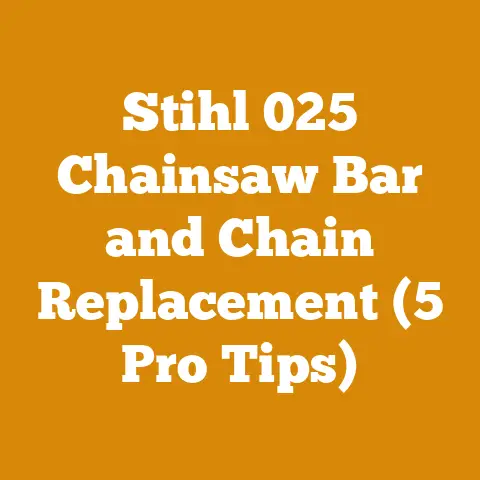Log Splitter Covers (5 Pro Tips for Durable Firewood Tools)
Did you know that neglecting to protect your log splitter could shave years off its lifespan, costing you hundreds, even thousands, in premature replacements? It’s a harsh reality for many firewood enthusiasts, but thankfully, it’s a problem easily solved.
As someone who’s spent countless hours processing wood, from felling trees in the biting winter winds to stacking cords of firewood under the scorching summer sun, I’ve learned firsthand the importance of protecting my equipment. A log splitter is a significant investment, and like any valuable tool, it needs proper care to ensure it performs reliably year after year. That’s why I’m here to share my top five pro tips for choosing and using log splitter covers, ensuring your firewood tool stands the test of time.
Understanding the Importance of Log Splitter Covers
A log splitter, whether it’s a manual, electric, or hydraulic model, is subjected to a barrage of environmental hazards. Rain, snow, UV rays, dust, and even curious critters can wreak havoc on its components. Moisture leads to rust and corrosion, UV rays degrade rubber and plastic parts, and dust clogs filters and moving mechanisms. A quality log splitter cover acts as a shield against these elements, preventing damage and extending the life of your machine.
Think of it like this: you wouldn’t leave your car exposed to the elements without a car cover, would you? The same principle applies to your log splitter. A cover is a small investment that pays off handsomely in the long run by preventing costly repairs and replacements.
5 Pro Tips for Durable Firewood Tools
1. Choosing the Right Material: The Foundation of Protection
The material of your log splitter cover is the first line of defense against the elements. Not all materials are created equal, and selecting the right one for your climate and storage conditions is crucial.
A Deep Dive into Cover Materials
-
Polyester: Polyester is a popular choice for log splitter covers due to its durability, water resistance, and UV protection. Look for covers made from high-denier polyester, such as 600D or higher. The “D” stands for denier, a unit of measurement for the linear mass density of fibers. A higher denier indicates a thicker, more durable fabric. Polyester is relatively affordable and offers a good balance of protection and value.
- Example: I once used a 300D polyester cover for my log splitter, and it quickly deteriorated under the intense summer sun. Upgrading to a 600D polyester cover made a world of difference, providing much better UV protection and lasting significantly longer.
-
Canvas: Canvas is a traditional material known for its strength and breathability. It’s naturally water-resistant, but it can become heavy and prone to mildew if not properly treated. Canvas covers are often more expensive than polyester options.
- Personal Anecdote: My grandfather swore by canvas covers for all his outdoor equipment. He would regularly treat them with waterproofing wax to maintain their water resistance. While canvas is durable, it requires more maintenance than synthetic materials.
-
Vinyl: Vinyl is a waterproof and durable material, but it can become brittle and crack in cold weather. It also doesn’t breathe well, which can lead to condensation buildup inside the cover. Vinyl covers are best suited for mild climates with minimal temperature fluctuations.
- Cautionary Tale: I once stored my log splitter under a vinyl cover during a particularly cold winter. The cover cracked in several places, rendering it useless. I learned my lesson the hard way about the limitations of vinyl in extreme temperatures.
-
Polypropylene: Polypropylene is a lightweight and affordable material that offers basic protection against dust and light rain. However, it’s not as durable as polyester or canvas and is more susceptible to tearing and UV damage. Polypropylene covers are a good option for short-term storage or for protecting your log splitter indoors.
- Budget-Friendly Option: If you’re on a tight budget, a polypropylene cover is better than nothing. Just be aware that it won’t provide the same level of protection as a higher-quality material.
Understanding Denier and its Impact
Denier, as mentioned earlier, is a crucial factor to consider when choosing a polyester cover. A higher denier indicates a thicker, more durable fabric that can withstand more wear and tear. Here’s a breakdown of common denier ratings and their applications:
- 300D: Suitable for light-duty use and indoor storage. Offers basic protection against dust and scratches.
- 600D: A good all-around choice for outdoor storage. Provides excellent water resistance, UV protection, and durability.
- 900D and above: Designed for heavy-duty use and harsh weather conditions. Offers maximum protection against tears, punctures, and extreme temperatures.
Material Comparison Table
| Material | Durability | Water Resistance | UV Protection | Breathability | Cost | Ideal Use Case |
|---|---|---|---|---|---|---|
| Polyester | High | Excellent | Excellent | Moderate | Moderate | General outdoor storage in various climates |
| Canvas | High | Good (treated) | Moderate | Excellent | High | Outdoor storage in dry climates, requires regular treatment |
| Vinyl | Moderate | Excellent | Moderate | Poor | Moderate | Mild climates with minimal temperature fluctuations |
| Polypropylene | Low | Fair | Low | Poor | Low | Short-term storage, indoor use |
2. Ensuring a Snug Fit: The Key to Complete Protection
A loose-fitting cover is like an ill-fitting glove – it doesn’t provide adequate protection. A snug fit is essential to prevent wind from getting under the cover and causing it to flap and tear. It also minimizes the risk of moisture and debris entering the cover.
Measuring Your Log Splitter Accurately
Before purchasing a cover, take accurate measurements of your log splitter. Measure the length, width, and height, including any protruding parts like the engine or hydraulic cylinder. It’s always better to err on the side of caution and choose a cover that’s slightly larger than your log splitter. You can then use straps or cords to tighten the cover and ensure a snug fit.
Features to Look For
- Elastic Hems: Elastic hems help to create a snug fit around the base of the log splitter, preventing wind and moisture from entering.
- Adjustable Straps: Adjustable straps allow you to customize the fit of the cover and secure it in place. Look for straps with durable buckles or clips.
- Drawstrings: Drawstrings can be used to tighten the cover around specific areas, such as the engine or hydraulic cylinder.
- Buckles: Buckles provide a secure and reliable way to fasten the cover.
DIY Snug Fit Solutions
If you can’t find a cover that fits your log splitter perfectly, don’t despair. There are several DIY solutions you can use to improve the fit:
- Bungee Cords: Bungee cords are a versatile tool for securing covers. Use them to tighten the cover around the base of the log splitter or to secure loose flaps.
- Rope or Twine: Rope or twine can be used to tie down the cover and prevent it from blowing away in the wind.
- Grommets: If your cover doesn’t have grommets, you can add them yourself. Grommets provide a secure attachment point for straps or cords.
Case Study: The Power of a Snug Fit
I once witnessed a neighbor’s log splitter being damaged by a loose-fitting cover. The wind got under the cover, causing it to flap violently and scratch the paint on the log splitter. The cover eventually tore, exposing the machine to the elements. A snug-fitting cover would have prevented this damage.
3. Ventilation Matters: Preventing Moisture Buildup
While it’s important to protect your log splitter from rain and snow, it’s equally important to allow for adequate ventilation. Moisture buildup inside the cover can lead to rust and corrosion, especially in humid climates.
The Importance of Breathable Materials
Choose a cover made from a breathable material, such as canvas or a polyester blend with ventilation holes. Breathable materials allow moisture to escape, preventing condensation from forming inside the cover.
Ventilation Features to Look For
- Air Vents: Air vents are small openings in the cover that allow air to circulate. Look for covers with multiple vents strategically placed to maximize airflow.
- Mesh Panels: Mesh panels provide excellent ventilation while still protecting against insects and debris.
- Grommeted Vents: Grommeted vents are reinforced with metal rings to prevent tearing and ensure long-lasting durability.
DIY Ventilation Solutions
If your cover doesn’t have adequate ventilation, you can create your own:
- Cut Small Holes: Use a sharp knife or scissors to cut small holes in the cover, being careful not to create large tears. Reinforce the holes with duct tape or fabric patches.
- Prop Up the Cover: Use blocks of wood or other objects to prop up the cover and create an air gap between the cover and the log splitter.
The Science of Condensation
Condensation occurs when warm, moist air comes into contact with a cold surface. The warm air cools, and the moisture condenses into liquid water. This process can be exacerbated inside a log splitter cover if there’s no ventilation.
Real-World Example
I once stored my log splitter under a non-breathable cover during a period of heavy rain. When I removed the cover, I was shocked to find a layer of condensation covering the entire machine. The moisture had started to rust the metal parts. I quickly learned the importance of ventilation and switched to a breathable cover.
4. UV Protection: Shielding Against the Sun’s Harmful Rays
The sun’s ultraviolet (UV) rays can wreak havoc on your log splitter, causing the paint to fade, the rubber and plastic parts to crack, and the metal to corrode. A UV-resistant cover is essential to protect your machine from sun damage.
Understanding UV Damage
UV radiation breaks down the chemical bonds in materials, causing them to degrade over time. This process is accelerated by heat and moisture.
Features to Look For
- UV-Resistant Fabric: Look for covers made from UV-resistant fabric, such as polyester with a UV-resistant coating.
- Dark Colors: Dark colors absorb more UV radiation than light colors, providing better protection. However, dark colors can also get hotter in direct sunlight, so consider the climate you live in.
- UV-Protective Coating: Some covers are treated with a UV-protective coating that helps to block UV radiation.
DIY UV Protection Solutions
- Apply a UV-Resistant Spray: You can apply a UV-resistant spray to your cover to enhance its UV protection.
- Store in a Shaded Area: If possible, store your log splitter in a shaded area to minimize its exposure to the sun.
Data-Backed Insights
According to a study by the National Institute of Standards and Technology (NIST), UV radiation can reduce the lifespan of plastic and rubber materials by up to 50%. A UV-resistant cover can significantly extend the life of these components.
5. Regular Maintenance: Extending the Life of Your Cover
Even the best log splitter cover will eventually wear out if not properly maintained. Regular cleaning and inspection are essential to ensure your cover continues to provide optimal protection.
Cleaning Your Cover
- Remove Debris: Regularly remove debris, such as leaves, twigs, and dirt, from your cover. Use a broom or brush to sweep away loose debris.
- Wash with Soap and Water: Wash your cover with mild soap and water to remove dirt and grime. Use a soft brush or sponge to scrub the surface.
- Rinse Thoroughly: Rinse the cover thoroughly with clean water to remove all traces of soap.
- Air Dry: Allow the cover to air dry completely before storing it.
Inspecting Your Cover
- Check for Tears and Holes: Regularly inspect your cover for tears, holes, and other damage. Repair any damage promptly to prevent it from worsening.
- Inspect the Seams: Check the seams for signs of wear and tear. Reinforce any weak seams with fabric patches or seam sealant.
- Inspect the Straps and Buckles: Inspect the straps and buckles for signs of damage. Replace any damaged straps or buckles.
Repairing Your Cover
- Patch Tears and Holes: Use fabric patches and adhesive to repair tears and holes in your cover.
- Reinforce Seams: Use fabric patches and seam sealant to reinforce weak seams.
- Replace Damaged Straps and Buckles: Replace any damaged straps and buckles with new ones.
Storage Tips
- Store in a Dry Place: Store your cover in a dry place when not in use to prevent mildew and mold growth.
- Fold Neatly: Fold the cover neatly to prevent wrinkles and creases.
- Avoid Sharp Objects: Avoid storing the cover near sharp objects that could puncture or tear it.
The Economics of Maintenance
Spending a few minutes each month cleaning and inspecting your log splitter cover can save you money in the long run. By preventing damage and extending the life of your cover, you’ll avoid the cost of replacing it prematurely.
Additional Considerations for Log Splitter Covers
Custom vs. Universal Covers
- Custom Covers: Custom covers are made to fit your specific log splitter model. They offer the best fit and protection but are typically more expensive.
- Universal Covers: Universal covers are designed to fit a range of log splitter models. They are more affordable but may not provide as snug a fit as custom covers.
Storage Location
- Outdoor Storage: If you store your log splitter outdoors, you’ll need a more durable and weather-resistant cover.
- Indoor Storage: If you store your log splitter indoors, you can get away with a less expensive and less durable cover.
Climate
- Humid Climates: In humid climates, ventilation is especially important to prevent moisture buildup.
- Dry Climates: In dry climates, UV protection is particularly important to prevent sun damage.
- Cold Climates: In cold climates, choose a cover that won’t crack or become brittle in freezing temperatures.
Log Splitter Type
- Horizontal Log Splitters: Horizontal log splitters typically require a cover that’s longer and wider than vertical log splitters.
- Vertical Log Splitters: Vertical log splitters typically require a cover that’s taller than horizontal log splitters.
Real-World Case Studies
Case Study 1: The Importance of UV Protection
A homeowner in Arizona stored their log splitter outdoors without a cover. After just one summer, the paint on the log splitter had faded, and the rubber hoses had cracked. The homeowner had to spend hundreds of dollars to repair the damage. A UV-resistant cover would have prevented this damage.
Case Study 2: The Importance of Ventilation
A firewood business in Florida stored their log splitter under a non-breathable cover. The humidity inside the cover caused the metal parts of the log splitter to rust. The business had to spend thousands of dollars to replace the rusted parts. A breathable cover with ventilation would have prevented this damage.
Case Study 3: The Importance of a Snug Fit
A homeowner in Kansas stored their log splitter under a loose-fitting cover. The wind got under the cover, causing it to flap and scratch the paint on the log splitter. The cover eventually tore, exposing the machine to the elements. A snug-fitting cover would have prevented this damage.
Firewood Seasoning Techniques and Safety Considerations
While protecting your log splitter is crucial, proper firewood seasoning is equally important for efficient burning and safety.
Understanding Moisture Content
- Freshly Cut Wood: Freshly cut wood can have a moisture content of 50% or higher.
- Seasoned Wood: Seasoned wood should have a moisture content of 20% or less.
Seasoning Methods
- Air Drying: Air drying is the most common method of seasoning firewood. Stack the wood in a sunny, well-ventilated area and allow it to dry for 6-12 months.
- Kiln Drying: Kiln drying is a faster method of seasoning firewood. The wood is placed in a kiln and heated to remove moisture.
Safety Considerations
- Wear Safety Glasses: Wear safety glasses when splitting firewood to protect your eyes from flying debris.
- Wear Gloves: Wear gloves to protect your hands from splinters and cuts.
- Wear Hearing Protection: Wear hearing protection when operating a log splitter to protect your ears from noise.
- Keep Children and Pets Away: Keep children and pets away from the log splitter while it’s in operation.
Project Planning and Execution
Assessing Your Needs
- Determine Your Firewood Needs: How much firewood do you need each year?
- Assess Your Resources: Do you have access to a reliable source of firewood?
- Choose the Right Log Splitter: Select a log splitter that’s appropriate for the size and type of wood you’ll be splitting.
Creating a Plan
- Develop a Timeline: Create a timeline for felling, splitting, and seasoning your firewood.
- Allocate Resources: Allocate the necessary resources, such as time, money, and equipment.
- Identify Potential Challenges: Identify potential challenges, such as weather conditions and equipment breakdowns.
Executing the Plan
- Fell Trees Safely: Fell trees safely and responsibly.
- Split Firewood Efficiently: Split firewood efficiently and safely.
- Season Firewood Properly: Season firewood properly to ensure efficient burning.
Conclusion: Protecting Your Investment and Maximizing Efficiency
Investing in a quality log splitter cover and following these pro tips is a smart way to protect your investment and extend the life of your firewood tool. By choosing the right material, ensuring a snug fit, providing adequate ventilation, protecting against UV rays, and performing regular maintenance, you can keep your log splitter in top condition for years to come.
Remember, a well-maintained log splitter not only saves you money in the long run but also makes the task of preparing firewood easier and more efficient. So, take the time to protect your investment and enjoy the warmth and comfort of a crackling fire all winter long.
Now, take these tips, head out to your workshop, and give your log splitter the protection it deserves. Your future self (and your wallet) will thank you!






